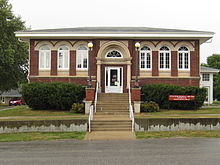Huntsville, Missouri
Daniel Hunt, a Kentuckian, was the first settler of Huntsville, in honor of whom the town was named.
The first courthouse was built in the center of the public square at the precise meeting point of the four parcels of land; it was completed by June 13, 1831.
The next courthouse stood on the same site between 1858 and 1882, being expanded and remodeled in 1877 by architect Charles B. Clarke.
It reads as thus: "On October 17 and 18, 1838, about 850 Potawatomi Indians camped near Huntsville, on their way from northern Indiana to Kansas; a forced march accompanied by soldiers.
Having travelled 13 miles in cold, rain, a flooded camp caused them to stay a second day."
The Society and friends support and maintain a Museum which opened in 1975 in the old Westlake Hardware store in downtown Huntsville on Main Street.
The Museum is available to the public with the mission to collect, preserve and disseminate historical information about Huntsville.
Students are offered participation in football, basketball, softball, baseball, track, golf, cheerleading, as well as other sports.
The Huntsville Lincoln School was built on Randolph Street and provided education for African-American children from first to eighth grade.
About 1935, pupils were transported to the Moberly Lincoln High School for the eleventh and twelfth grades.
A charter was granted and the cornerstone was laid and work began on Mount Pleasant College in 1855.
[11] Huntsville was well known for its commerce, producing salt, coal, hemp rope, and tobacco.
In June, 2000 the Randolph County jail, located in Huntsville, was the scene of a shooting as part of an attempted escape.
[12] According to the United States Census Bureau, the city has a total area of 2.39 square miles (6.19 km2), all land.

